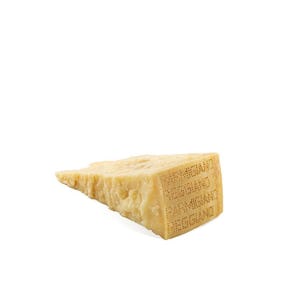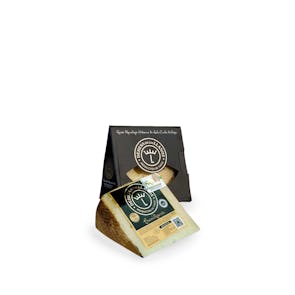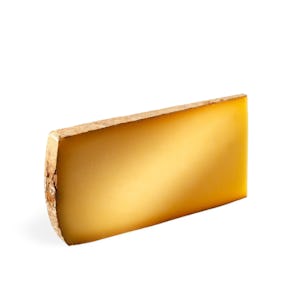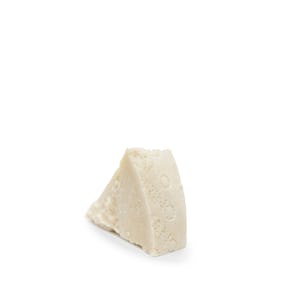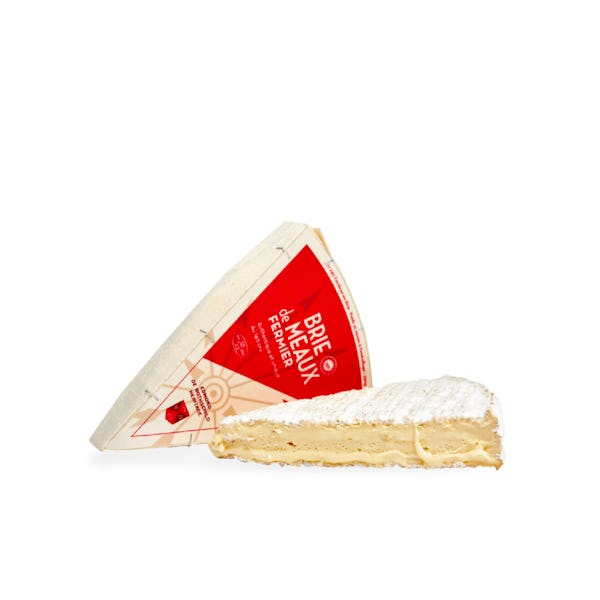

Brie de Meaux Fermier Edmond de Rothschild AOP
Aristocratic farmhouse divinity
TASTING NOTES FROM THE CURATOR
The “fermier” label on this Brie means something real – it’s truly made on the farm, and the Rothschild version delivers on that promise wonderfully. This cheese comes from one farm’s cows, where what they eat throughout the changing seasons creates amazing flavors. When you first smell it, you’ll notice fresh mushrooms, autumn leaves, and rich cream. Cut it open and you’ll see how it changes from firm in the middle to soft near the rind – that’s the sign of perfect aging.
What makes this Brie special is its deep savory flavor – think beef broth and roasted nuts underneath the expected buttery taste. The AOP stamp isn’t just for show – it guarantees this cheese is made the traditional way in the exact region around Meaux, just as it has been for centuries. While the Rothschild name ensures quality, it’s really the farmers who know each cow personally that create this cheese – a team effort between people, animals, helpful bacteria, and time.
PREPARATION OR PAIRINGS
The Brie de Meaux Fermier Edmond de Rothschild demands ceremonial respect but rewards with democratic pleasure. Consider these approaches to maximizing your experience:
- Solo contemplation: First encounter this cheese alone on warmed stoneware, nothing but perhaps a torn piece of baguette tradition to provide textural counterpoint.
- Fruit companionship: Honeycrisp apples sliced whisper-thin or black cherries when in season create sweet-savory dialogues that amplify the cheese’s complexity.
- Beverage diplomacy: A mature red Burgundy with some bottle age speaks the same language of forest floor and mushroom. Alternatively, try a demi-sec Champagne whose subtle sweetness plays beautifully against the cheese’s savory depth. For beer enthusiasts, a Belgian Trappist ale with notes of dark fruit and spice creates a monastic conversation.
- Culinary applications: Incorporate into a twice-baked soufflé where its farmhouse character can anchor more delicate flavors, or melt gently over roasted fingerling potatoes finished with fresh thyme.
The Rothschild Legacy of Protected Tradition
When the Rothschild family decided to produce Brie de Meaux on their estate, they didn’t simply enter the cheese business—they became guardians of a culinary tradition. For generations, the Rothschilds have maintained their commitment to authentic farmhouse production, honoring the AOP (Appellation d’Origine Protégée) regulations not as limitations but as a blueprint for excellence. Their farmlands in the Île-de-France region provide the perfect terroir for their dedicated herd of dairy cows, whose milk becomes these exceptional wheels of Brie.
The AOP designation, awarded to Brie de Meaux in 1980, requires strict adherence to traditional methods: raw milk must be used, the cheese must be made within a specific geographical area, and it must be hand-ladled into molds (a process called “moulage à la louche”). The Rothschild estate embraces these requirements with characteristic attention to detail, employing master cheesemakers who understand that excellence comes from respecting both tradition and place.
Their Brie exemplifies why the AOP matters—it’s not just about protecting a name, but preserving a specific taste experience that connects us to centuries of French cheese-making heritage. In each bite of Rothschild Brie de Meaux Fermier, you’re tasting not just milk transformed, but history preserved through the stewardship of a family known for valuing tradition and quality above all.
Storage Instructions
Store between 2-4°C, wrapped in the specialized cheese paper or in waxed paper that allows the cheese to breathe. Ideally, consume within 7-10 days of purchase. Before serving, unwrap and allow 1-2 hours at room temperature for full flavor development. Once cut, re-wrap with fresh paper after each use.









